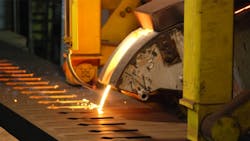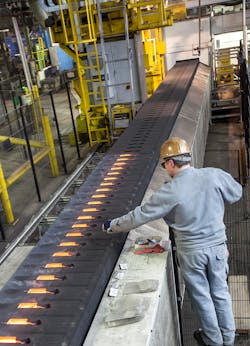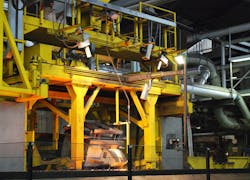Federal-Mogul Develops New Molding Process
Federal-Mogul Corporation's Powertrain Segment has developed a new casting process for steel piston rings that are more wear-resistant than gray iron. Relatedly, it also developed a casting simulation process that provides precise data to optimize the material flow, pressure, and filling of the piston ring casting molds.
Federal-Mogul designs and manufactures powertrain and other component parts for auto, commercial vehicle, marine, rail, aerospace, power generation and industrial markets.
"As engine manufacturers continue to pursue strong engine downsizing and more advanced injection strategies to reduce fuel consumption and CO2 emissions, the thermal, mechanical and tribological demands on components around the combustion chamber - particularly piston rings – increases,” according to Dr. Steffen Hoppe, director of technology, Rings and Liners for the Federal-Mogul Powertrain business.
“While engine friction can be reduced through the use of thinner piston rings, a stronger ring material is necessary in order to maintain the proper bending strength," he continued. "To achieve these requirements, we have developed new materials, casting and simulation processes."
The company’s standard production process for piston rings has been “stack casting,” multiple molds assembled in horizontal layers, which results in variable molten-metal pressure and flow velocity. The one-piece molds also reduce the range of piston ring designs that can be cast.
Federal-Mogul said its new vertical casting process uses a special mold design that provides new opportunities for optimizing the design of the blanks and gating systems, which improves metal flow control.
The new process — which is installed at Federal-Mogul’s ferrous foundry in Burscheid, Germany — feeds molten metal around the complete circumference of the mold, which improves significantly the uniformity of graphite formation in the gray iron. The fully automatic molding and pouring process includes extensive monitoring and in-process documentation of all relevant parameters. The process developers claim this ensures more reproducible molten metal flow rates and more thorough mold filling, which results in more consistent piston ring quality.
High-Speed Cameras, Not FE Modeling
Federal-Mogul also developed a new casting simulation method using high-speed cameras to overcome the limitations of conventional finite element (FE) modeling. "FE simulation has one major drawback," explained Hoppe. "No matter how fine a network is selected, the 'macro process' is still simulated. How close the simulation is to reality always depends on how well the simulation parameters are chosen and set."
Federal-Mogul said its Slow-Motion Casting Simulation (SMCS) technique provides a more detailed analysis of mold filling, enabling more precise optimization of the complex gating and feeder systems that control molten material flow. It means molten metal flow at different temperatures and casting speeds can be tracked more effectively, improving understanding and control of pressure fluctuations and the reactions of mold gases.
Federal-Mogul said its new casting process provided the opportunity to develop a new steel material for its piston ring products. The cast steel material, GOE70, has a martensitic matrix structure with embedded chromium carbides, and strength of at least 1,800 MPa. This formulation can be improved by adding nitriding, for a surface hardness of up to 1,300 HV.
The developer said piston rings made from GOE70 were subjected to a high number of endurance tests on heavy-duty diesel engines and showed exceptionally low side face wear and high durability. That means engine manufacturers can reduce exhaust gas blow-by and lower oil consumption.
Federal-Mogul said series production of GOE70 piston rings began last year, and the first application on a highly loaded heavy-duty engine met EU6 emissions standards.
Piston rings produce by the process are being supplied to diesel and gasoline engine builders for passenger cars as well as commercial vehicle engines, though the primary application is in automotive engines Hoppe indicated.
He also reported that the vertical molding/stack casting process would be applied only to Federal-Mogul’s piston ring products, and not other casting programs.
"Through the development of innovative casting, molding and simulation technologies that provide enhanced control of key process parameters, we have achieved improved product quality and increased strength and wear resistance," Hoppe said.


